Learn how to understand Ohm’s law, how it works as well as how to use it.
There’s also 2 problems at the end of the article for you to test your knowledge and solve.
Scroll to the bottom to watch the YouTube tutorial.
What Is Ohm’s Law
Ohm’s law is the relationship between voltage, current and resistance and how they relate to each other. Ohm’s law was developed by a German physicist named Georg Ohm who undertook many experiments to develop his theory including measuring current by touching electrical circuits to see how much it hurt. The higher the current, the more it hurt.
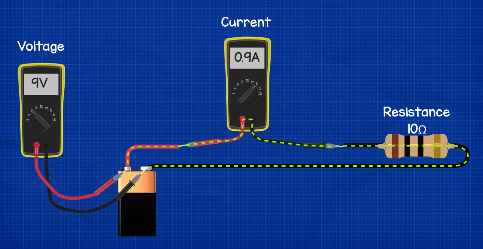
Ohm’s Law formulas
Now there are three formulas we need to use for ohms law. BUT we don’t need to remember these as we’ll show you a super easy tip in just a moment.
So the three formulas we use are:
- Voltage = Current x Resistance
- Current = Voltage / Resistance
- Resistance = Voltage / Current
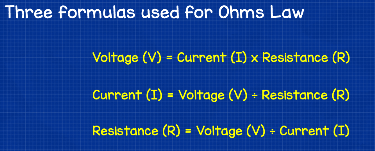
If that seems like a lot to remember then don’t worry because you don’t need to remember them. All you need to remember is Ohm’s triangle which looks like the image below.
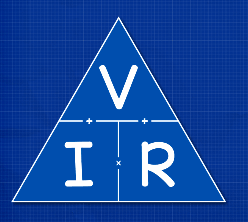
So you just need to remember the three letters in this order, VIR. Then just write them in a triangle with V at the top and draw a line to separate them.
In fact you don’t even need to remember those because we’ve made a FREE PDF guide with some worked examples which you can keep on your PC or mobile and access whenever you need. Click here to download
Now all we do when we need to use a formula is cover up the letter we need.
To Find Voltage
So if we want to find the voltage, we write V = and then cover up the V in the triangle, that leaves us with I and R. So we write I x R. Which means Voltage = Current multiplied by Resistance. You can write a little multiplication symbol in the triangle between the two letters if it helps you.
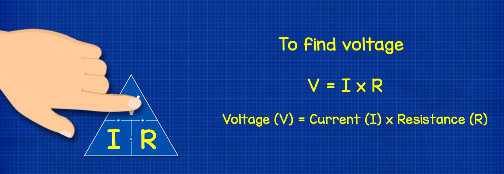
We know what you’re thinking. Why is current represented with the letter I and not a C for current or even an A for the unit for Amperes. Well the unit of current is the Ampere or Amp which is named after André Ampère, a french physicist. A couple of hundred years ago he undertook lots of experiments many involved varying the amount of electrical current, so he called this intensité du courant or intensity of current. So when they published his work, they took the letter I and it become standard until this day.
You might also come across formulas where the letter E is used instead of V. The E stands for EMF or electromotive force but don’t worry about that, just stick with using V and substitute V for E if you see it used in an Ohms law question.

By covering V we get voltage = Current multiplied by Resistance.
To Find Current
If we want to find Current then we write down I = and then cover up the letter I. That gives us V and R and as V is above the R like a fraction, we can write V ÷ R. Therefore Current is equal to Voltage divided by Resistance.
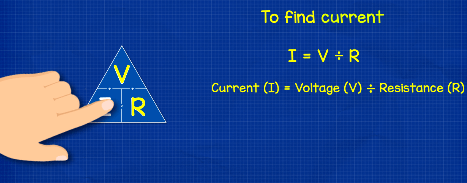
To Find Resistance
If we want to find Resistance then we write R = and cover up the R, that leaves us with V and I so we write V ÷ I which gives us resistance = Voltage divided by current.
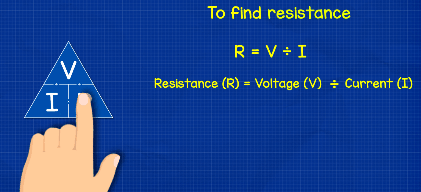
Let’s look at some examples for how to use these formulas. First, lets see how we find voltage and how it relates to the other parts.
Finding Voltage Example
Lets say we have a simple electrical circuit with a battery and a resistor. We don’t know what voltage the battery is though. The resistor is 3Ω and when we connect a multimeter into the circuit we see that we get a reading of 2 Amps.

We want to find the voltage so using ohms triangle we cover up V and that gives us V = I x R. We know the current is 2 Amps so we write that in and we know the Resistance is 3 Ohms so we write that in too. Therefore 2A multiplied by 3Ω gives us 6 Volts. The battery is therefore 6V.
If you want to check your answers the you can use our FREE Ohm’s Law Calculator. Click here.
If we double the voltage by connecting two 6V batteries in series, we get 12V. If we now connect this to the same circuit, the current also doubles from 2A to 4A. If we double the voltage again to 24V the current will also double to 8A.
What’s the relationship here? We can see that current is therefore directly proportional to voltage.
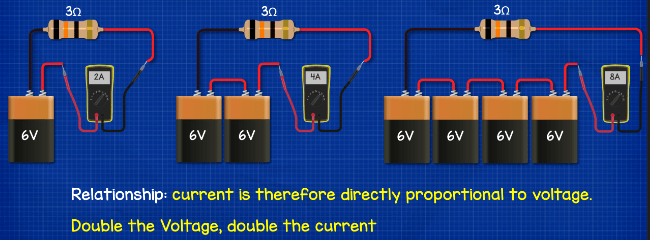
Remember; voltage is like pressure. It’s the pushing force in the circuit. It pushes the electrons around the wires and we place things like lamps in the way of the electrons so they have to flow through it and this causes the lamp to light up.
By doubling the voltage we see that the current also doubles, meaning more electrons flow as we apply more pressure. Just like if we use a bigger pump, more water will flow.
Finding Current Example
Lets say we now have a 3Ω lamp connected to a 6V power supply. To find the current we write down I = and cover up the I in the triangle. That gives us V ÷ R so Current equals Voltage divided by resistance. We know the voltage is 6V and the resistance is 3 ohm so the current is therefore 2A and that’s what we see with the multimeter.
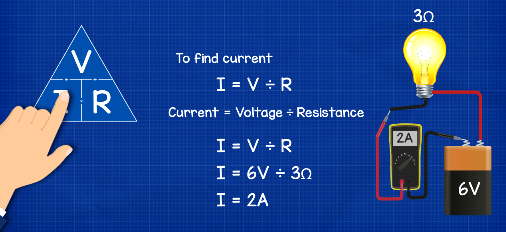
By the way if you don’t have a multimeter then we highly recommend you get one, it’s essential for trouble shooting and also building your electrical knowledge. There are some links down below for which one to get and from where.
So we saw what happens when we use a resistance of 3 ohms in the circuit. But If we double the resistance to 6 ohms by placing another 3 ohm lamp into the circuit, the current halves to 1A.
If we double the resistance again to 12 Ohms, the current will half again to 0.5A. We can visually see this because the lamps will become less bright as the current reduces from the increase in resistance.
What’s the relationship here? We can see that the current is inversely proportional to resistance. When we double the resistance the current will decrease by half. If we half the resistance, the current will double.

Current is the flow of electrons or the flow of free electrons. For us to make this lamp shine we need to push electrons through it. How do we do that? We apply a voltage across the two ends. The voltage will push the electrons. The atoms inside the copper wire have free electrons in their valance shell which means they can very easily move to other copper atoms and they will naturally move to other atoms by themselves but in random directions which is no use to us. For the lamp to turn on we need lots of electrons to flow in the same direction. When we connect a voltage source we use the pressure of the battery to push the electrons through the circuit all in the same direction.
For example, to power this 1.5 ohm resistive lamp with a 1.5V battery, requires 1 amp of current which is equal to (6,242,000,000,000,000,000) six quintillion two hundred and forty two quadrillion electrons passing from the battery and through the lamp, every second, for the lamp to stay on at full brightness. If the voltage or current reduces or the resistance of the circuit increases then the lamp will become dimmer.
Finding Resistance Example
Say we have a resistive lamp connected to a 12V power supply. We don’t know how much resistance it’s adding to the circuit but we measure the current as 0.5 A.
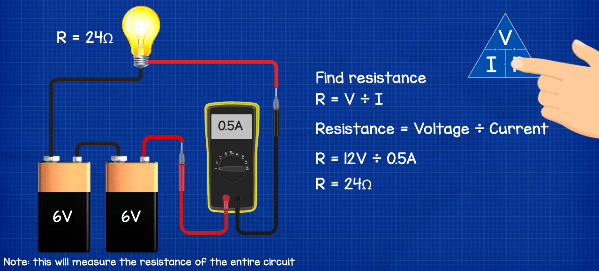
To find resistance we write down R = and cover up the R on the triangle. We’re left with V and I so Resistance = Voltage divided by current. We know the voltage is 12V and the current is 0.5A so 12 divided by 0.5 gives us 24 Ohms of resistance.
Resistance is the opposition to the flow of electrons. It tries to prevent electrons from flowing. That’s why we use resistors in circuits to reduce the current and protect the components such as an LED. If we tried to connect an LED directly to a 9V battery it will blow out because the voltage and current are too high. But when we add a resistor into the circuit, these are reduced so the LED is protected and will shine brightly.
So given a circuit, we can increase the current by increasing the voltage or we can also increase the current but reducing the resistance. We can also reduce the current by increasing the resistance.

Test Your Skills
Can you solve these problems?
Problem 1) Lets say we have this lamp which has a resistance of 240 ohms. If we plug this into an outlet in the US, which uses 120V, what will the current be?
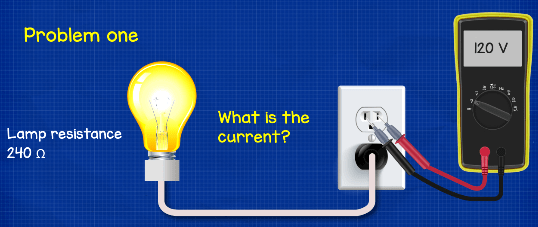
Problem 2) If I plugged the same 240 ohm resistor lamp into an outlet in the UK, we get a current of 0.958A, so what is the voltage being applied?
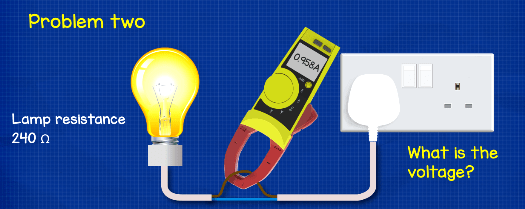
Solutions
Problem 1) To solve for current we use the formula I = V ÷ R. We know the resistance R is 240 Ω and we know the voltage V is 120V so we drop these numbers into the formula to get
I = V ÷ R
I = 120V ÷ 240 Ω
I = 0.5A
Problem 2) To solve for voltage we use the formula V = I x R. We know the current (I) is 0.958A and the resistance (R) is 240 Ω so we drop these numbers into the formula to get
V = I x R
V = 0.958A x 240Ω
V = 229.9V (~230V)

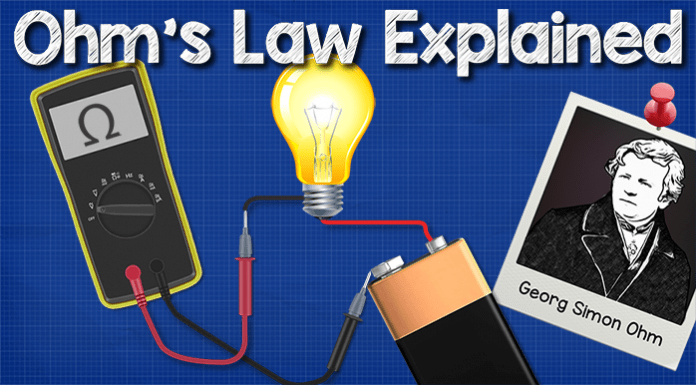





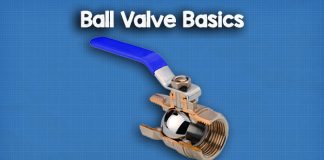
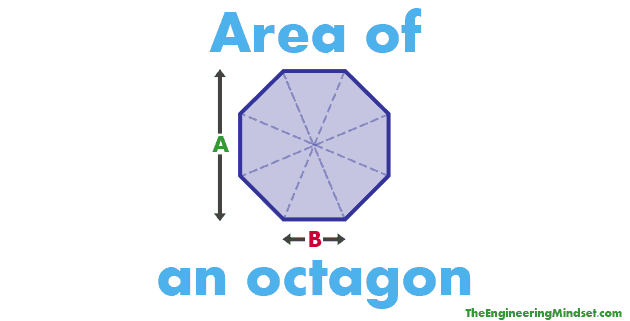
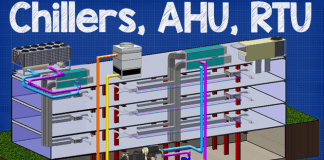
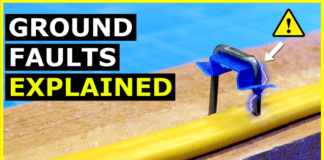
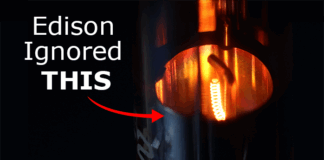







Really useful information for my Students.As Covid19 has restricted access to college I will be tutoring via the internet.I shall direct my students to your site.Thank you.
I’ve read that The National Grid transfer electricity at high voltage and a low current because that reduces the resistance and therefore energy loss. This seem to go against ohms law. I’ve clearly not understood something. Can you help?
Hey Nathan,
Power loss is in form of heat energy given as I^2*R. So, by keeping current low, the heat loss is minimized significantly.
The resistance of the power lines is not reduced. Energy loss IS reduced because current is kept low. Power companies use transformers to increase voltage from low to high voltage. The total power IN to a transformer must equal total power OUT. As power P = Voltage x Current. then to maintain this balance if the output voltage in a transformer is increased then the output current will decrease.
The resistance of the power lines is not reduced. Energy loss IS reduced because current is kept low. Power companies use transformers to increase voltage from low to high voltage. The total power IN to a transformer must equal total power OUT. As power P = Voltage x Current. then to maintain this balance if the output voltage in a transformer is increased then the output current will decrease.
Thank you very much for this Amazing Channel and Website .
I learned a lot from this videos.
I’m an electrician from a small island in the pacific called Nauru. I’ve been an electrician for more than 30years, we’re using As/nz standards and the voltage is 230-240v. I really enjoy your videos especially when I’m teaching the younger apprentice the basic of how electrical works. Showing them your video’s is very helpful and showing them in real life work is easier for me. Thanks for the great video’s.. cheers
Nice info
succinct, explicit content for all ages, many thanks!
Perfect little method. Thank you very much.
Your videos are like drinking water from a fire hose – but
I love them. LOL
These are all terrific videos! Thank you for posting them and making them so easily understood.
THANK YOU FOR MAKING and explaining all of these wonderful video you have helped ,me learn so much in the last 6 months!
Really appreciate you. Thank u so much Sir
I never thought of electricity to be so easy to understand and this shows me really how schools can’t explain in a simple way like you do. Thanks man appreciated and keep the hard work.
Mabey next time don’t write as much however very interesting topic